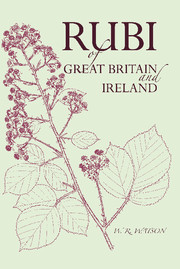Book contents
- Frontmatter
- Foreword
- Preface
- Contents
- INTRODUCTION
- I Environmental variations
- II Genetic intraspecific variations
- III Chromosomes and genes
- IV Reproduction
- V The species in Rubus
- VI Ecesis and migration
- VII Enemies, pests and diseases
- VIII Classification
- IX Collection and identification
- X Characteristics of the British-Irish bramble flora
- XI Cultivating native blackberries for fruit
- XII Note on the nomenclatural type species for the genus Rubus and subgenus Rubus
- XIII Key to the vice-county numbers
- XIV Signs and abbreviations
- ARRANGEMENT OF THE GENUS RUBUS LINN. IN AN ANALYTICAL KEY
- DESCRIPTIONS
- DRAWINGS
- Glossary
- Principal works consulted
- Index
X - Characteristics of the British-Irish bramble flora
Published online by Cambridge University Press: 05 June 2016
- Frontmatter
- Foreword
- Preface
- Contents
- INTRODUCTION
- I Environmental variations
- II Genetic intraspecific variations
- III Chromosomes and genes
- IV Reproduction
- V The species in Rubus
- VI Ecesis and migration
- VII Enemies, pests and diseases
- VIII Classification
- IX Collection and identification
- X Characteristics of the British-Irish bramble flora
- XI Cultivating native blackberries for fruit
- XII Note on the nomenclatural type species for the genus Rubus and subgenus Rubus
- XIII Key to the vice-county numbers
- XIV Signs and abbreviations
- ARRANGEMENT OF THE GENUS RUBUS LINN. IN AN ANALYTICAL KEY
- DESCRIPTIONS
- DRAWINGS
- Glossary
- Principal works consulted
- Index
Summary
The characteristics of the British-Irish bramble flora are brought out when a comparison is made of them statistically group by group with the brambles of a near and a far part of western Europe. North France with Belgium, and Bavaria with Pfalz and Alsace, have been chosen, as their bramble flora is well known and they suit the requirements for a just comparison with Britain. North France comprises the departments of Nord, Pas-de-Calais, Somme, Ardennes, Aisne and Oise: Nord is low and flat, Ardennes is upland to moderately mountainous, the other departments are hilly. Belgium is low in the north, high and mountainous in the south. Both north France and Belgium are entirely periglacial. Alsace consists of mountain (Vosges) and plain (Rhine); Pfalz consists of mountain (Hardt Mts.) and plain (Rhine); Bavaria consists of high Alps, high plateau, forests and the wide Danube plain.
The greater frequency of EUGLANDULOSI in mountainous country (Belgium and the Bavaria group) will be noticed. The high proportion of endemics in Britain and Ireland in all groups except DISCOLORES and EUGLANDULOSI is also remarkable, especially in SYLVATICI, MUCRONATI, DISPARES and GRANDIFOLII, all of which groups possess characters shown in east Atlantic, Macaronese species; that is to say, short or slightly sigmoid prickles, large flowers, scarcity or absence of glands on the barren stem, but an abundance on the panicle, together with, in some instances, highly developed, intricately branched, pyramidal panicles. A high degree of endemism in species incorporating such characters must be regarded as marking an ancient flora.
On the other hand it is shown that a low proportion of endemics is general on the Continent. In Switzerland, too, there is apparently only one endemic species. Dr R Keller claimed three in 1922, but two of these have been found in other countries, R. Barbeyi Favrat & Gremli in France, Loire-et-Cher, and R. Fischer-Oosteri Sudre in Belgium, Vierset-Barse.
On the Continent species of HYSTRICES number about one-half of the species of EUGLANDULOSI, but here the proportion is reversed, the species of HYSTRICES being twice as numerous as those of EUGLANDULOSI. Our DISCOLORES number less than one-half of the VESTITI, but in north France, Belgium and the Bavaria group they number the same as the VESTITI. The EUGLANDULOSI have a wide distribution in the east and are numerously represented there.
- Type
- Chapter
- Information
- Handbook of the Rubi of Great Britain and Ireland , pp. 20 - 22Publisher: Cambridge University PressPrint publication year: 2013



